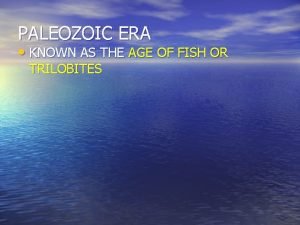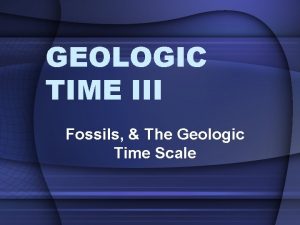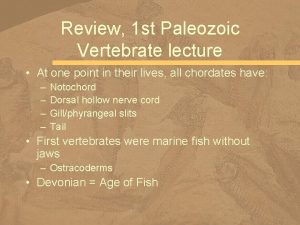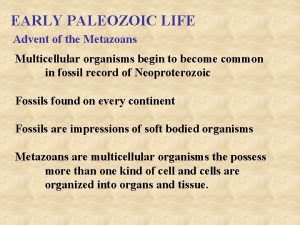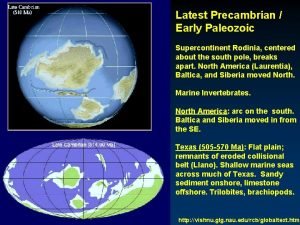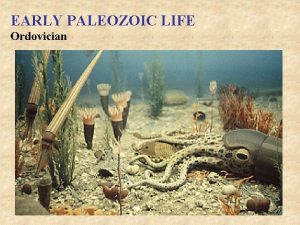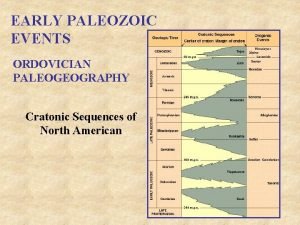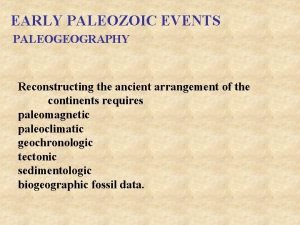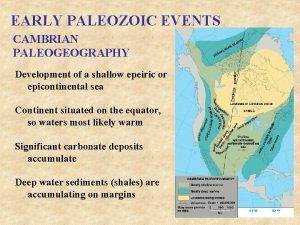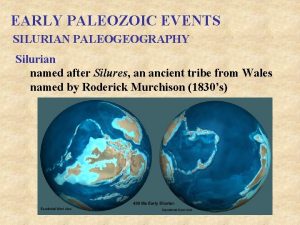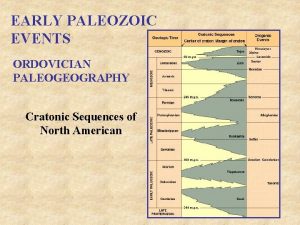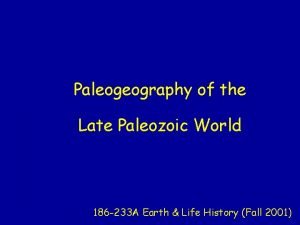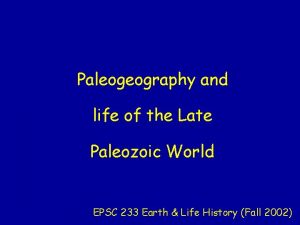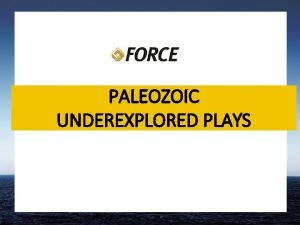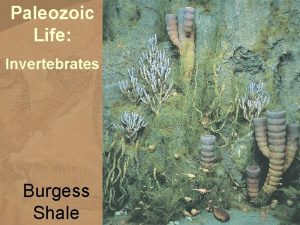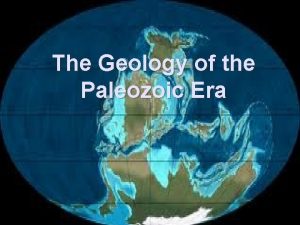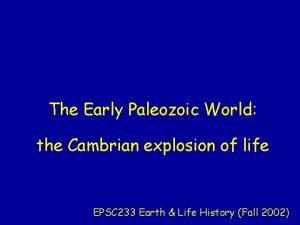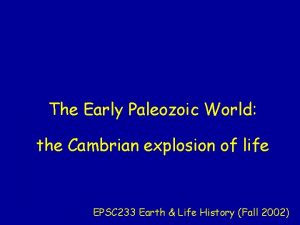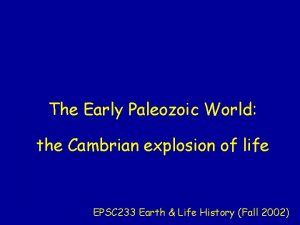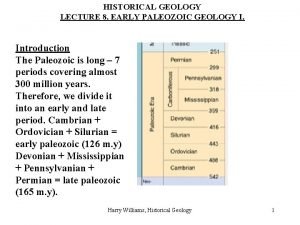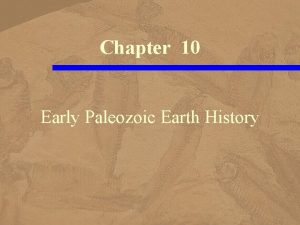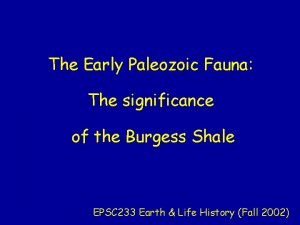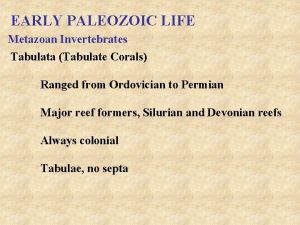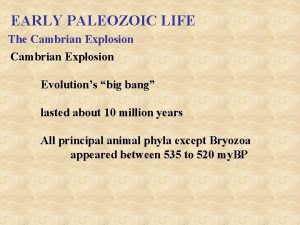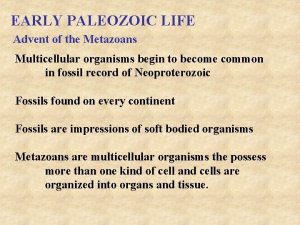The Early Paleozoic World the paleogeography of the



























- Slides: 27

The Early Paleozoic World: the paleogeography of the Cambrian Earth EPSC-233 Earth & Life History (Fall 2002)

Recommended reading: STANLEY “Earth System History” Chapter 13, pp. 355 -357. See also pp. 285 -286 about paleomagnetism. Keywords: correlation, paleomagnetism (remanent magnetism), inclination of magnetic field, unconformity, sandstone, trace fossils (burrows and tracks)

Towards the end of the Precambrian, most supercontinents were probably clustered in a single supercontinent. This gathering of most continents in a single huge supercontinent may have happened more than once during the Proterozoic.

Possible shape of Rodinia.

By the end of the Proterozoic, Rodinia had broken up and most continents were quite close to the equator.

What lines of evidence can we use to reconstruct the position of continents in the past? -the position of sedimentary belts that formed along the edges of continents when they broke up again - the dates of igneous intrusions that are part of mountain chains along ancient continental margins - the “fossil” (or remanent) magnetism of some Fe-rich Precambrian rocks.

Paleomagnetism The core of the Earth is largely iron. Its outer shell (shown in yellow) is liquid. Motions within this liquid generate the Earth’s magnetic field.

Paleogeographic reconstructions The Earth’s magnetic field is almost like that of giant bar magnet. A compass needle points to the north pole of that magnetic field.

-Remanent magnetism is the “fossil magnetism” acquired by a rock during its formation, under the influence of the Earth’s magnetic field. - igneous rock containing magnetite (Fe 3 O 4) - sedimentary rock containing magnetite grains (such as the banded iron formations) The crystals settling from the magma or seawater will orient themselves relative to the Earth’s magnetic field, like small compass needles.

If it has not been altered, this ancient magnetism (called remanent magnetism) provides 2 pieces of information. 1) polarity of the magnetic field: was the magnetic north pole pointing towards the geographic North pole, or to the geographic South pole? (. . . yes, the magnetic poles “switch” from time to time!) 2) inclination of the magnetic field, which varies with latitude.

The inclination of the magnetic field, relative to the Earth’s surface, is high in a rock formed near the pole, and it decreases for rocks closer to the equator.

This inclination (which depends on the latitude at which the rock formed) is not the same as the declination (slight deviation of magnetic North pole from geographic North pole). This magnetism can be preserved for hundreds of millions of years, as long as the rock is not strongly reheated again. This “fossilized magnetism” is called remanent magnetism or paleomagnetism. The temperature at which the magnetism of a magnetite-rich rock could be modified again is called the Curie point (about 550 º C for magnetite).

Reconstructions of the movements of tectonic plates take into account this paleomagnetic information. Rocks are taken back to the lab, after their exact orientation in the field is recorded, and their paleomagnetism is measured in laboratory. If the paleomagnetism shows a very low inclination relative to the Earth’s surface, the rock formed near the tropics. Specimens with a field at higher inclination must have formed at higher latitudes.

The break-up of Rodinia led to the repositioning of large continental surfaces at low latitudes (tropical and subtropical zones). In most areas, this Precambrian-Cambrian interval left a gap in the sedimentary (and fossil) record. Such gaps (periods of erosion and non-deposition) are called UNCONFORMITIES. This indicates that the surface of most cratons stood largely ABOVE sea level.

Drift of continents during the Cambrian: 600, 540 and 525 million years ago. A “proto-Atlantic” called Iapetus is created along east coast of N. America.

Laurentia and Baltica (joined in Rodinia) rifted along a zone which became a mid-ocean ridge.

This is how all oceans are born. . . (They are not “dug up” by rivers. . In fact rivers brings sediment and salt to the oceans. ) New oceans form when crust rifts apart, and some of the faulted blocks sink down (because it is cooler and denser than the hot mafic magma underneath). Sinking large blocks of crust creates a very large “hole” that water gradually fills in. As the opening widens, it connects with other oceans and becomes full of seawater.

Mid-ocean ridges are regions where new crust forms continuously from magma rising from the upper mantle.

Cambrian: concentric belts of sandstones, limestones and shales accumulated all around the margins of Laurentia.

Grand Canyon: Angular unconformity between 1 billion year old Dox Proterozoic sandstone and the Cambrian Tapeats sandstone. Layers are at different angles in Tapeats and in Dox.

How an unconformity may form. . . 1) sediments laid flat 1 billion years ago 3) erosion 2) sedimentary rocks tilted (and faulted) 4) Cambrian sediments

In Ontario and Quebec, the Precambrian shield is exposed on much of the territory because later rocks were scraped away by “recent” glaciers.

In southern Ontario and Quebec, there a few places where we can see the Precambrian-Cambrian contact. The first sedimentary rock is a sandstone, derived by weathering of continental rocks.

Most Cambrian sandstones are poor in fossils. - the nearshore environment is a highenergy zone where the remains of dead animals are rarely preserved intact. - a sandstone can remain quite porous during sedimentary burial. The decay of organic matter tends to make pore waters acidic, and shells tend to dissolve.

-trace fossil Skolithos, a simple vertical dwelling burrow dug by a filterfeeding animal - a few simple tracks are the most common Cambrian fossils preserved in the Potsdam sandstone (Ontario, Quebec, NE United States). The Potsdam sandstone itself is widely quarried and used as flagstone for paths and facing stones for buildings.

Climactichnites, an enigmatic Cambrian crawler immortalized on the Potsdam sandstone. Slab collected by William Logan (the discoverer of “Eozoon canadense”).

Near Kingston, the Potsdam is eolian (sand wind-blown into dunes that were preserved). This year, footprints were discovered in some eolian Potsdam. . . Something crawled out of the water about 500 Ma ago.
 Paleozoic era vs mesozoic
Paleozoic era vs mesozoic Paleozoic era pangea
Paleozoic era pangea What is an eon
What is an eon What was the late paleozoic
What was the late paleozoic Crucible
Crucible Paleozoic supercontinent
Paleozoic supercontinent Early cpr and early defibrillation can: *
Early cpr and early defibrillation can: * Primate characteristics
Primate characteristics Are oranges old world or new world
Are oranges old world or new world Real world vs digital world
Real world vs digital world The world of ideas plato
The world of ideas plato Ap world history chapter 25 africa and the atlantic world
Ap world history chapter 25 africa and the atlantic world The changing world output and world trade picture
The changing world output and world trade picture Countries michael jackson visited
Countries michael jackson visited Awarding the world its world
Awarding the world its world An elementary school classroom in a slum by stephen spender
An elementary school classroom in a slum by stephen spender English world 1 unit 9
English world 1 unit 9 The changing world output and world trade picture
The changing world output and world trade picture Hát kết hợp bộ gõ cơ thể
Hát kết hợp bộ gõ cơ thể Lp html
Lp html Bổ thể
Bổ thể Tỉ lệ cơ thể trẻ em
Tỉ lệ cơ thể trẻ em Chó sói
Chó sói Chụp phim tư thế worms-breton
Chụp phim tư thế worms-breton Chúa sống lại
Chúa sống lại Môn thể thao bắt đầu bằng chữ đua
Môn thể thao bắt đầu bằng chữ đua Thế nào là hệ số cao nhất
Thế nào là hệ số cao nhất Các châu lục và đại dương trên thế giới
Các châu lục và đại dương trên thế giới

